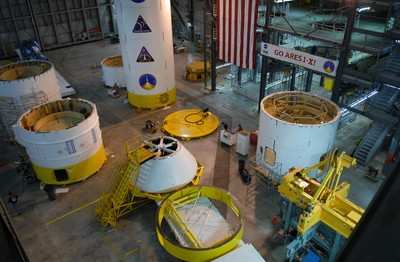Tue, Jun 30, 2009
Vibrations During Launch Might Cause Severe Problems, USAF
Says
 Air Force Officials, who are charged with safety during
launch operations at Kennedy Space Center, are concerned that
harmonic vibrations from the cluster of solid rocket boosters used
on the Ares I-X could knock out both the launch vehicle's Thrust
Vector Control and self destruct mechanism. The result, officials
say, could be extremely dangerous for people living along Florida's
east coast.
Air Force Officials, who are charged with safety during
launch operations at Kennedy Space Center, are concerned that
harmonic vibrations from the cluster of solid rocket boosters used
on the Ares I-X could knock out both the launch vehicle's Thrust
Vector Control and self destruct mechanism. The result, officials
say, could be extremely dangerous for people living along Florida's
east coast.
The concerns may delay or even cancel the planned August 30th
test launch, according to an exclusive report in The Orlando
Sentinel.
While the solid rocket boosters are proven technology, Jon
Cowart, NASA's deputy Ares I-X program manager, told the paper
that "if you change little things, it's amazing the amount of
reanalysis you have to go do. You're not starting from scratch. But
you're not as far down the road as you probably thought you
were."
The Ares-I will eventually carry astronauts back to the moon,
but those missions aren't planned for more than a decade.
Engineers used the same self-destruct mechanism on the Ares I-X
as are used on the shuttle, but the vibrations during launch are
apparently much more severe. According to internal NASA documents
obtained by the paper, the vibrations with enough force to knock
out the self-destruct mechanism could come 60-90 seconds into the
flight, with a TVC failure coming as much as 2 minutes into the
flight. The Air Force requires an assurance that the self-destruct
system will work properly, 99.9 percent, according to Lt. Col.
Loretta Kelemen, head of the Cape Canaveral Air Force Station 45th
Space Wing Range Safety Office. "If they do not meet our
requirements, then they do not launch here."

Cower told the paper he doesn't think the vibrations, which are
called "sympathetic" among the SRB's and could cause the vehicle to
act like a tuning fork, will ever be severe enough to effect either
the Thrust Vector Control or the Flight Termination System. "We've
done our analysis one way. They do it another way."
More News
Aero Linx: Model Aeronautical Association of Australia MAAA clubs are about fun flying, camaraderie and community. For over 75 years, the MAAA has been Australia’s largest fl>[...]
Touchdown Zone Lighting Two rows of transverse light bars located symmetrically about the runway centerline normally at 100 foot intervals. The basic system extends 3,000 feet alon>[...]
“Discovery and innovation are central to our mission at Virgin Galactic. We’re excited to build on our successful record of facilitating scientific experiments in subor>[...]
How To Get A Story On Aero-TV News/Feature Programming How do I submit a story idea or lead to Aero-TV? If you would like to submit a story idea or lead, please contact Jim Campbel>[...]
Student Pilot Reported That During Rotation, “All Of A Sudden The Back Of The Plane Kicked To The Right..." Analysis: The student pilot reported that during rotation, “>[...]
 ANN's Daily Aero-Linx (05.02.24)
ANN's Daily Aero-Linx (05.02.24) ANN's Daily Aero-Term (05.02.24): Touchdown Zone Lighting
ANN's Daily Aero-Term (05.02.24): Touchdown Zone Lighting Aero-News: Quote of the Day (05.02.24)
Aero-News: Quote of the Day (05.02.24) ANN FAQ: Contributing To Aero-TV
ANN FAQ: Contributing To Aero-TV NTSB Final Report: Cirrus Design Corp SR20
NTSB Final Report: Cirrus Design Corp SR20




